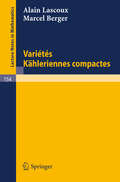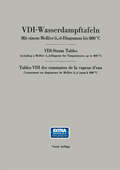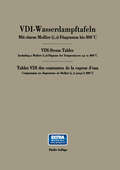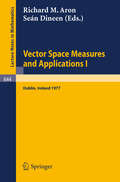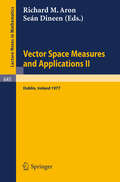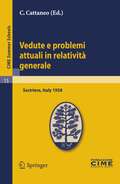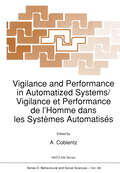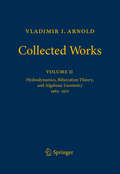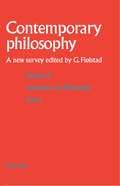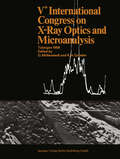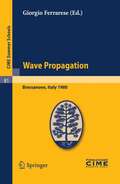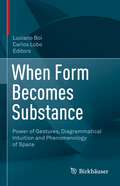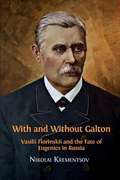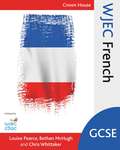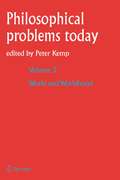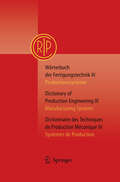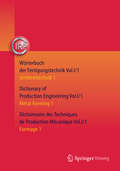- Table View
- List View
VDI-Wasserdampftafeln / VDI-Steam Tables / Tables VDI des constantes: Mit einem Mollier (i, s)-Diagramm bis 800 °C / Including a Mollier (i, s)-Diagram for Temperatures up to 800°C / de la vapeur d’eau Comprenant un diagramme de Mollier (i, s) jusqu’à 800°C
by Werner KochMaßeinheiten, Bezeichnungen und Vereinbarungen. l In den internationalen Konferenzen über Maßeinheiten hat man sich in den letzten Jahren auf das MKS-System geeinigt mit den Grundeinheiten Meter, Kilogramm (Masse) und Sekunde. Einheit der Kraft 2 in diesem System ist die Kraft, die der Masse 1 kg die Beschleunigung 1 m/s erteilt; sie heißt Newton, ab 5 gekürzt N, es ist 1 N = 10 dyn. Einheit der Energie und damit auch der Wärmemenge ist das Newton Meter, das man mit Joule, abgekürzt J, bezeichnet, ein Joule ist gleich einer Wattsekunde. Einheit des Druckes ist das Newton je Quadratmeter. Da diese Größe recht klein ist, wird ein dezimales Vielfaches davon, 5 2 das Bar, benutzt, 10 N/m = 1 bar. Tempet"aturen werden gemessen in der Kelvinskala, definiert durch den absoluten Nullpunkt bei ° °K und den Tripelpunkt des Wassers bei 273,16 0K. Der Eispunkt, dem man bisher die Temperatur 273,16 °K zuschrieb, liegt dann bei 273,15 0K. Diese geringe Änderung von 0,01 °K gegen die frühere Festlegung ist praktisch belanglos. Die Benützung des MKS-Systems wird angestrebt, aber seine Einführung erfordert eine längere Über gangszeit, während der man auf die Kalorie und das Kraftkilogramm noch nicht wird verzichten können. Diese Einheiten verlieren aber ihre ursprüngliche Bedeutung als selbständige Grundeinheiten, sondern sie werden auf die Einheiten des MKS-Systems mit Hilfe von Umrechnungszahlen zurückgeführt.
VDI-Wasserdampftafeln / VDI-Steam Tables / Tables VDI des constantes de la vapeur d’eau: Mit einem Mollier (i, s)-Diagramm bis 800°C / Including a Mollier (i, s)-Diagram for Temperatures up to 800°C / Comprenant un diagramme de Mollier (i, s) jusqu’à 800°C
by Werner KochVector Space Measures and Applications I: Proceedings, Dublin, 1977 (Lecture Notes in Mathematics #644)
by R. M. Aron S. DineenVector Space Measures and Applications II: Proceedings, Dublin 1977 (Lecture Notes in Mathematics #645)
by R. M. Aron S. DineenVedute e problemi attuali in relatività generale: Lectures given at a Summer School of the Centro Internazionale Matematico Estivo (C.I.M.E.) held in Sestriere (Torino), Italy, July 20-30, 1958 (C.I.M.E. Summer Schools #15)
by C. CattaneoLectures: P.B. Bergmann: Problems of Quantization.- A. Lichnerowicz: Radiations gravitationelles et éléctromagnétiques en relativité generale.- J.L. Synge: The geometry of space-time.- Seminars: C. Cattaneo: Grandezze relative standard in relatività generale.- E. Clauser: Moto di particelle nell´ultima teoria unitaria einsteiniana.
Vertical Readings in Dante's Comedy
by George Corbett Heather WebbVertical Readings in Dante’s Comedy is a reappraisal of the poem by an international team of thirty-four scholars. Each vertical reading analyses three same-numbered cantos from the three canticles: Inferno i, Purgatorio i and Paradiso i; Inferno ii, Purgatorio ii and Paradiso ii; etc. Although scholars have suggested before that there are correspondences between same-numbered cantos that beg to be explored, this is the first time that the approach has been pursued in a systematic fashion across the poem. This collection – to be issued in three volumes – offers an unprecedented repertoire of vertical readings for the whole poem. As the first volume exemplifies, vertical reading not only articulates unexamined connections between the three canticles but also unlocks engaging new ways to enter into core concerns of the poem. The three volumes thereby provide an indispensable resource for scholars, students and enthusiasts of Dante. The volume has its origin in a series of thirty-three public lectures held in Trinity College, the University of Cambridge (2012-2016) which can be accessed at the ‘Cambridge Vertical Readings in Dante’s Comedy’ website. This series would not have been possible without the generosity of certain sponsors: Trinity College; Selwyn College; the Italian Department, University of Cambridge; the Cambridge Italian Research Network (CIRN); the Centre for Medieval Literature (University of Southern Denmark and University of York); the University of Notre Dame; and the School of Languages, Cultures and Societies, University of Leeds.
Vertical Readings in Dante's Comedy: Volume 3
by George Corbett Heather WebbVertical Readings in Dante’s Comedy is a reappraisal of the poem by an international team of thirty-four scholars. Each vertical reading analyses three same-numbered cantos from the three canticles: Inferno i, Purgatorio i and Paradiso i; Inferno ii, Purgatorio ii and Paradiso ii; etc. Although scholars have suggested before that there are correspondences between same-numbered cantos that beg to be explored, this is the first time that the approach has been pursued in a systematic fashion across the poem. This collection in three volumes offers an unprecedented repertoire of vertical readings for the whole poem. As the first volume exemplifies, vertical reading not only articulates unexamined connections between the three canticles but also unlocks engaging new ways to enter into core concerns of the poem. The three volumes thereby provide an indispensable resource for scholars, students and enthusiasts of Dante. The volume has its origin in a series of thirty-three public lectures held in Trinity College, the University of Cambridge (2012-2016) which can be accessed at the Cambridge Vertical Readings in Dante’s Comedy website.
Vigilance and Performance in Automatized Systems/Vigilance et Performance de l’Homme dans les Systèmes Automatisés (NATO Science Series D: #49)
by A. CoblentzVladimir I. Arnold - Collected Works: Hydrodynamics, Bifurcation Theory, and Algebraic Geometry 1965-1972 (Vladimir I. Arnold - Collected Works)
by Vladimir I. ArnoldVladimir Arnold was one of the great mathematical scientists of our time. He is famous for both the breadth and the depth of his work. At the same time he is one of the most prolific and outstanding mathematical authors. This second volume of his Collected Works focuses on hydrodynamics, bifurcation theory, and algebraic geometry.
Voltaire et l'économie politique (Oxford University Studies in the Enlightenment #2012:10)
by Patrick NeiertzL’économie politique, qui ose se constituer en science vers le milieu du XVIIIe siècle, n’a cessé de passionner Voltaire. S’il n’est pas un théoricien de l’économie, il en est un observateur attentif et critique, et un acteur même de l’économie pratique: financier avisé, il construit, au fil de sa longue vie, l’une des grandes fortunes du royaume.Patrick Neiertz présente ici la première étude d’ensemble des idées économiques de Voltaire en analysant l’application expérimentale qu’il fait des théories de son temps (Melon, Quesnay, Turgot, Adam Smith…) dans sa propre pratique de consommateur, de gestionnaire de ses biens, enfin, d’entrepreneur. Se font jour les réactions du patriarche de Ferney aux conceptualisations économiques en formation: sur les finances publiques, sur la consommation des biens superflus, sur l’agriculture, sur l’avenir de l’industrie, sur la liberté du commerce. Il entretient auprès de ses correspondants ou lecteurs ce flux d’influence à sa manière d’écrivain, faite d’érudition et d’ironie, et à sa manière d’intellectuel engagé, en faveur de la liberté de faire comme de dire.Les idées de Voltaire sur la dette publique, sur l’assiette fiscale, sur le plein emploi, et sur le rôle de l’Etat ont une singulière modernité au siècle actuel. Son autorité n’est pas seulement celle d’un philosophe des Lumières. Elle est aussi celle d’un praticien de l’économie appliquée, ‘chose qui n’est pas ordinaire aux gens de lettres’.
Voltaire et l'écriture de l'histoire: un enjeu politique (Oxford University Studies in the Enlightenment #2012:02)
by Myrtille Méricam-BourdetBien qu’il participe à une redéfinition de la pratique historiographique à l’Age classique, on s’est peu interrogé sur l’art de ‘Voltaire l’historien’, et on a souvent résumé sa conception de l’histoire et de la politique au rôle majeur joué par les ‘grands hommes’. Il s’agit ici de mettre à l’épreuve une telle conception, et de faire valoir la complexité de la lecture voltairienne de l’histoire.M. Méricam-Bourdet découvre et examine dans les écrits historiques de Voltaire une vision réfléchie du pouvoir et des enjeux du politique, bien que l’auteur lui-même n’en ait jamais proposé de théorisation systématique: pour comprendre le déroulement historique, il faut prendre en compte l’action non seulement de quelques souverains, mais aussi celle, collective, des peuples. Tout aussi révélatrice est l’attention que porte Voltaire aux rapports de pouvoir qui infléchissent les politiques contemporaines: relations internationales et commerce se retrouvent au premier plan d’une œuvre qui envisage la politique comme un phénomène global.En raison de ces multiples enjeux, l’œuvre historique de Voltaire est alors en prise avec une actualité politique et polémique. Par son analyse de cette tonalité spécifique, M. Méricam-Bourdet remet en question ce qu’est pour nous l’écriture de l’histoire au dix-huitième siècle.
Voltaire, le Philosophe Ignorant (Vif #8)
by VoltaireMoins connu du public que les Lettres philosophiques ou le Traité sur la tolérance, Le Philosophe ignorant peut être considéré comme la synthèse, sous une forme claire et didactique, de toute la philosophie de Voltaire. Il y exprime un profond scepticisme qui se dégage de la conscience des limites de notre intelligence et de notre savoir. Il se veut surtout une leçon de modestie devant les monuments grandioses, mais fragiles, de la métaphysique classique. Ce texte est disponible, pour la première fois, dans une édition critique qui s’adresse à un public étudiant.
Volume 9: Aesthetics and Philosophy of Art (Contemporary Philosophy: A New Survey #9)
by Guttorm FløistadThis book continues the series Contemporary Philosophy (International Institute of Philosophy), which surveys significant trends in contemporary philosophy. The new volume on Aesthetics, comprising nineteen surveys, shows the variety of approaches to Aesthetics in various cultures. The close connection between aesthetics and religion and between aesthetics and ethics is emphasized in several contributions.
Vth International Congress on X-Ray Optics and Microanalysis / V. Internationaler Kongreß für Röntgenoptik und Mikroanalyse / Ve Congrès International sur l’Optique des Rayons X et la Microanalyse: Tübingen, September 9th–14th, 1968
by Gottfried Möllenstedt K. H. GauklerThe Fifth International Congress on X-Ray Optics and Microanalysis was organized by the Institute of Applied Physics at Tübingen University in Western Germany from September 9th through 14th, 1968. Since 1956, when the First Conference was arranged in Cambridge, England by one of the pioneers in this field, V. E. CossLETT, the experts in the fields of X-Ray Optics and Microanalysis have met every third year to exchange their scientific experiences. Later meetings were held at Uppsala, Sweden in 1959, at Stanford, California in 1962, and at Orsay, Francein 1965. The participants in the 1968 Conference came from the following countries: Germany 140, France 60, Great Britain 55, USA 20, Netherlands 16, Switzerland 12, Austria 9, Sweden 7, Belgium 6, Japan 5, Italy 4, two each from Israel, Yugoslavia, Canada, Norway, Hungary and one each from Argentine, Poland, South Africa. As at the latest congress in Paris the following central topics were treated: General problems of X-ray optics, physical bases of electron beam microanalysis, quantitative problems of X-ray microanalysis, instrumentation, microdiffraction, applications to metal lurgy, mineralogy, and biology. An exhibition showing some of the most modern instruments formed an important part of the conference. The Springer-Verlag, Heidelberg, deserves thanks for the careful and speedy work they have performed in printing these conference proceedings. We are further indebted to all contributors of this volume for their kind cooperation. Tübingen, August 1969 G. MöLLENSTEDT and K. H.
Wave Propagation: Lectures given at a Summer School of the Centro Internazionale Matematico Estivo (C.I.M.E.) held in Bressanone (Bolzano), Italy, June 8-17, 1980 (C.I.M.E. Summer Schools #81)
by Giorgio FerrareseLectures: A. Jeffrey: Lectures on nonlinear wave propagation.- Y. Choquet-Bruhat: Ondes asymptotiques.- G. Boillat: Urti.- Seminars: D. Graffi: Sulla teoria dell’ottica non-lineare.- G. Grioli: Sulla propagazione del calore nei mezzi continui.- T. Manacorda: Onde nei solidi con vincoli interni.- T. Ruggeri: "Entropy principle" and main field for a non linear covariant system.- B. Straughan: Singular surfaces in dipolar materials and possible consequences for continuum mechanics
When Form Becomes Substance: Power of Gestures, Diagrammatical Intuition and Phenomenology of Space
by Luciano Boi Carlos LoboThis interdisciplinary volume collects contributions from experts in their respective fields with as common theme diagrams.Diagrams play a fundamental role in the mathematical visualization and philosophical analysis of forms in space. Some of the most interesting and profound recent developments in contemporary sciences, whether in topology, geometry, dynamic systems theory, quantum field theory or string theory, have been made possible by the introduction of new types of diagrams, which, in addition to their essential role in the discovery of new classes of spaces and phenomena, have contributed to enriching and clarifying the meaning of the operations, structures and properties that are at the heart of these spaces and phenomena.The volume gives a closer look at the scope and the nature of diagrams as constituents of mathematical and physical thought, their function in contemporary artistic work, and appraise, in particular, the actual importance of the diagrams of knots, of braids, of fields, of interaction, of strings in topology and geometry, in quantum physics and in cosmology, but also in theory of perception, in plastic arts and in philosophy. The editors carefully curated this volume to be an inspiration to students and researchers in philosophy, phenomenology, mathematics and the sciences, as well as artists, musicians and the general interested audience.
With and Without Galton: Vasilii Florinskii And The Fate Of Eugenics In Russia
by Nikolai KrementsovIn 1865, British polymath Francis Galton published his initial thoughts about the scientific field that would become ‘eugenics.’ The same year, Russian physician Vasilii Florinskii addressed similar issues in a sizeable treatise, entitled Human Perfection and Degeneration. Initially unheralded, Florinskii’s book would go on to have a remarkable afterlife in twentieth- and twenty-first-century Russia. In this lucid and insightful work, Nikolai Krementsov argues that the concept of eugenics brings together ideas, values, practices, and fears energised by a focus on the future. It has proven so seductive to different groups over time because it provides a way to grapple with fundamental existential questions of human nature and destiny. With and Without Galton develops this argument by tracing the life-story of Florinskii’s monograph from its uncelebrated arrival amid the Russian empire’s Great Reforms, to its reissue after the Bolshevik Revolution, its decline under Stalinism, and its subsequent resurgence: first, as a founding document of medical genetics, and most recently, as a manifesto for nationalists and racial purists. Krementsov’s meticulously researched ‘biography of a book’ sheds light not only on the peculiar fate of eugenics in Russia, but also on its convoluted transnational history, elucidating the field’s protean nature and its continuing and contested appeal to diverse audiences, multiple local trajectories, and global trends. It is required reading for historians of eugenics, science, medicine, education, literature, and Russia, and it will also appeal to the general reader looking for a deeper understanding of this challenging subject. Victoria College, University of Toronto, has generously contributed to the publication of this volume.
With and Without Galton: Vasilii Florinskii and the Fate of Eugenics in Russia
by Nikolai KrementsovIn 1865, British polymath Francis Galton published his initial thoughts about the scientific field that would become ‘eugenics.’ The same year, Russian physician Vasilii Florinskii addressed similar issues in a sizeable treatise, entitled Human Perfection and Degeneration. Initially unheralded, Florinskii’s book would go on to have a remarkable afterlife in twentieth- and twenty-first-century Russia. <p><p> In this lucid and insightful work, Nikolai Krementsov argues that the concept of eugenics brings together ideas, values, practices, and fears energised by a focus on the future. It has proven so seductive to different groups over time because it provides a way to grapple with fundamental existential questions of human nature and destiny. With and Without Galton develops this argument by tracing the life-story of Florinskii’s monograph from its uncelebrated arrival amid the Russian empire’s Great Reforms, to its reissue after the Bolshevik Revolution, its decline under Stalinism, and its subsequent resurgence: first, as a founding document of medical genetics, and most recently, as a manifesto for nationalists and racial purists. <p> Krementsov’s meticulously researched ‘biography of a book’ sheds light not only on the peculiar fate of eugenics in Russia, but also on its convoluted transnational history, elucidating the field’s protean nature and its continuing and contested appeal to diverse audiences, multiple local trajectories, and global trends. It is required reading for historians of eugenics, science, medicine, education, literature, and Russia, and it will also appeal to the general reader looking for a deeper understanding of this challenging subject.
Without Trace: An Utterly Gripping Detective Crime Thriller With An Unexpected Twist (Di Geraldine Steel Ser. #20)
by Leigh RussellWJEC GCSE French (PDF)
by Bethan McHugh Chris Whittaker Louise PearceWe are delighted to announce that we are working closely with WJEC to ensure endorsement of a new series of textbooks for modern foreign languages. This textbook covers the reformed GCSEs for Wales, which will be taught from 2016 and awarded for the first time in 2018. This new textbook, covering the French GCSE qualification, has been designed in conjunction with examiners, specification developers and experienced teachers to support learners through the challenges of the new specifications. The textbook offers engaging and relevant content and provides comprehensive coverage of the WJEC themes and sub-themes, incorporating all of the new exam components, including: Literary and authentic texts Listening and reading tasks that correspond to the regulator s requirements (please note the required audio files are available with the relevant teacher guide) Role plays, photo cards and conversation questions Translation (from and into French) Increased focus on grammar including grammar in context sections Opportunities for stretch and challenge
World and Worldhood / Monde et Mondanéité (Philosophical Problems Today #3)
by Peter Kemp Institut International de PhilosophIn this book philosophers try to answer the following question: What is globalization and what does "globe" or "world" (monde) signify? Rémi Brague returns to the Greek idea of the cosmos in order to track the worldhood (mondanéité) of the world, that is, the process by which the idea of the world is formed. Don Ihde shows how a world has developed, in which technologies are no longer considered neutral means serving the ends of human action, but become the very means by which people exist in the world. Vittorio Mathieu describes the economical world at two levels – that of the individual and that of society. Tomonobu Imamichi analyses the capacity of aesthetic experience to disclose a world other than the world of technological efficiency. Francisco Miró Quesada C. emphasises that the great political questions are not solvable without worldviews that express value systems. David Rasmussen describes sensus communis as a cosmopolitan concept, which founds a political globalization of the world. And Peter Kemp attempts to grasp the meaning of that globalization upon which the destiny of our planet depends.
Wörterbuch der Fertigungstechnik Bd. 3 / Dictionary of Production Engineering Vol. 3 / Dictionnaire des Techniques de Production Mécanique Vol. 3: Produktionssysteme / Manufacturing Systems / Systèmes de Production
by C.I.R.P., ParisDans ce volume III sont décrits des entités liées aux techniques de production comme les machines-outils, les systèmes de fabrication, les éléments de machines et leurs propriétés, ainsi que les différents postes de travail. D’autres concepts concernant la commande des fabrications avec leur préparation, la métrologie des procédés et leur surveillance, les systèmes informatiques, les CAO/FAO et les enregistrements de données, ainsi que la planification de la production et les études de fabrication, le flux des matériaux et la logistique, le stockage, les machines de manutention et de transport, le calcul des coûts et l’assurance qualité.
Wörterbuch der Fertigungstechnik. Dictionary of Production Engineering. Dictionnaire des Techniques de Production Mécanique Vol. I/1: Umformtechnik 1/Metal Forming 1/Formage 1
by R. P. C. OfficeThis part of a tri-lingual edition of the CIRP Dictionary of Production Engineering was compiled under the auspices of the International Institution of Production Engineering Research (C.I.R.P.) headquartered in Paris.Volumes I.1 and I.2 contain about 3400 terms for metal forming. They include: General terms of metal forming; Hot and die forging; Cold and warm forging and sheet metal working.Precise definitions are provided for nearly all terms, illustrations are included where needed. In addition, reference is made to national and international standards. Alphabetical indices for each of the three languages provide easy access to the terms.
